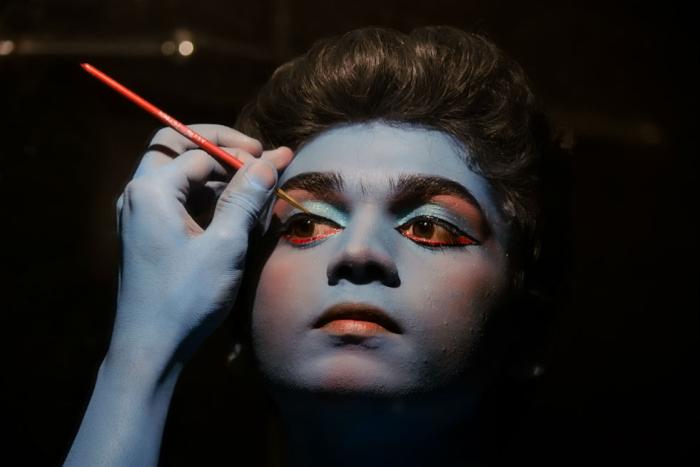This past spring, former radio personality Jian Ghomeshi was tried for the sexual assault of three women. During the highly publicized trial, observers seemed confused by the alleged victims’ expressions of pain and injury. Complainant Lucy DeCoutere wrote to Ghomeshi after he’d allegedly choked her one night in June 2003: “I love your hands,” she’d said of the very hands she’d claimed had hurt her. A photograph of her sitting close to Ghomeshi in a park after the alleged assault, clinging to him and looking happy, seemed a visual counterpart to the letter. Complainant Linda Redgrave emailed Ghomeshi a photograph of herself in a red bikini after the alleged assault. Questioning the women’s interactions with Ghomeshi and each other, many onlookers wondered if the complainants’ pain wasn’t hiding pleasure instead. The sentiment was familiar to me: A decade earlier, people had suggested that more than twenty young boys, myself included, hadn’t been assaulted by our former teacher, Douglas Ian Brown, but had really, in the words of one of his friends, “just wanted our willies pulled.”
In 2004, Brown went on trial for the sexual assault of children that began weeks, if not days, after his arrival in 1975 as a teacher at Upper Canada College, a private boys’ school in Toronto where I was a student for all but two years between 1970 and 1981. As one of his victims, I testified against him, becoming part of a highly public scandal and court case.
Brown was a serial predator who had visited at least twenty of us in our beds to repeatedly assault us. Police arrested him in 2001. In the intervening years between my assault and his arrest, my actions strongly paralleled the Ghomeshi Three’s emails, letters, photos, and slips of memory. I’d written letters about the abuse in which I minimized what had happened, letters I had no memory of writing; I’d even claimed when the police first interviewed me in 2000 that it hadn’t really been sexual abuse, hoping, I suppose, that labelling it as minor made it so. For years, I’d managed to forget the abuse altogether.
As I watched these three women being attacked for behaviour that felt so familiar, and found myself defending them from the criticisms of my online friends, I thought of Hanya Yanagihara. A photograph of a grimacing young man, who looks caught between pleasure and pain, graces the cover of her 2015 novel, A Little Life. The author had to fight for the image, titled "Orgasmic Man." Her editor felt that everyone would know that the man was having an orgasm, but Yanagihara defended and valued the ambiguity of his expression. Given the mystery of the inner world of the victim Yanagihara paints for the reader, the almost inevitable confusion of the observer is apt. As she told Kirkus Reviews, men she knew often couldn’t place the feelings they experienced; appropriately, the photograph evoked a male “helpless[ness]” in the realm of emotion. Yanagihara’s agent said the image “makes you pay attention—it makes you look, it makes you wonder....”
I spoke out against the scorn for Ghomeshi’s alleged victims because of what I myself had done before and during the Brown case. And as I explained to friends what trauma could do to your good sense and to your memory, I realized how wrong it was that the narrative I’d presented during the Brown trial—despite its gap-filled vagueness and hesitations, despite my ridiculous letters and denials—was somehow seen as more credible in the eyes of the law than these women’s words, brave dispatches from their own traumatic pasts. My response to trauma had, to use the words of Yanagihara’s agent, made people wonder. But the same response in the Ghomeshi victims made people condemn.
*
Redgrave was the first complainant to take the stand against Ghomeshi. She was cross-examined by his lawyer Marie Henein over the kind of car Ghomeshi had been driving when he allegedly assaulted her. Redgrave misremembered the model of the car—confusing two yellow Volkswagen models Ghomeshi had owned consecutively. Judge William B. Horkins, who presided over the trial, gave great importance to the fact that Redgrave had gotten this wrong, writing, “This demonstrably false memory weighs in the balance against the general reliability of L.R.’s evidence as a whole.” This would be one of many things the judge would cite as cause to acquit Ghomeshi. All three of the women seemed to have forgotten significant details of the alleged assaults, and to have failed to disclose the extent of their post-assault contact with Ghomeshi to the police and the Crown. The women were pilloried, not just for their failure to disclose post-assault behaviour but also for inconsistencies in their statements to media, to police and in court. But the perceived contradictions were only truly surprising to those unfamiliar with the swerves of abuse narratives.
It would take eight years, and a crisis precipitated by the ending of my academic career due to my crippling anxiety, before I was able to face up to what had happened to me.
Judge Horkins returned repeatedly to these moments in his judgement, saying the Ghomeshi complainants’ testimony undermined their credibility. But as Daniel Reisberg remarks in The Science of Perception and Memory: A Pragmatic Guide for the Justice System (2014), while common sense tells us that inconsistencies matter, science affirms the opposite. Science suggests that though memory and perception are “incomplete” and can be distorted, they yield a “generally accurate” picture of events. In other words, the inconsistencies are simply artifacts of what wasn’t noticed, or was filled in by inference—they don’t nullify the accuracy of the recollection of the central event. But still, Christie Blatchford, a newspaper columnist and prominent commentator on the trial, reported after the verdict in a broadcast from the steps of Toronto’s Old City Hall—activists’ chants of “We believe survivors” in the background—“The women in this case, two of whom were wholly discredited, Lucy DeCoutere and the third complainant, did it to themselves by editing their memories. This is not trauma. Trauma messes with your memory perhaps, but it doesn’t see you only take out the stuff that reflects poorly on you. ...” With what one defense lawyer I spoke to called “unnecessary harshness,” Blatchford went on to conclude, “... I think it was a good day for justice, a good day for adult women who want to be treated like any other complainant in the criminal justice system, and I say ‘hurray’ for Bill Horkins, the judge.”
*
In 2004, Blatchford covered the Brown trial for The Globe and Mail. In her reporting, she noted that among the victims, only I was present in court to hear Ontario Superior Court Justice Harry LaForme read his decision and find Brown, in LaForme’s words, “implausible, untrustworthy and unreliable,” while we victims were “reasonable and believable,” not to mention “intelligent, articulate, and forthright.”
I believed a boy I’ll call PT when he’d told me he’d been assaulted in 1975, while both the school and Brown denied it and his father insisted he mustn’t make things up. He’d phoned me one day late in 1992, and though we hadn’t spoken since the ’70s, when he asked me to guess why he was calling, without thinking, I blurted, “Mr. Brown.” The day I’d believed him had been the best day of his life, he told me, when we met soon after for a lunch of burgers and beer. He recounted what Brown had done to him, not just once or twice, but for years, and as we sat there, I started to have flashbacks. It was then that I began remembering events, feelings, sensations; and as my brain’s circuits, my neurons fired in recognition, I automatically began to think of new ways to deny and avoid that I’d been attacked.
Yet I agreed to write PT a letter, ostensibly for his therapist, to confirm that he’d immediately reported the assaults, and that I’d been assaulted too. Soon after, PT took that letter to the school to demand compensation, and two months later, having moved to England for grad school, standing in a brightly lit phone box in a dark field in Kent outside my residence, I was forced to respond to calls from the principal and the school’s lawyers who were eager to discuss my letter and my intentions.
We are, statistically speaking, a population that too easily blames victims of sexual assault.
In early 1993, with the trial still more than a decade away, I spoke to friends and family about the trouble that was already unfolding. The counsel was that Brown’s assaults hardly merited the name, since what trace had they really left, after all? I was told that I should distance myself from the whole sorry mess and not go to the police, and that I should write a second letter denouncing my first one. Desperate for distance from this unpleasantness, as I then saw it, I wrote a second, terrible letter saying that I wanted nothing more to do with it, that I hadn’t been damaged by Brown, and that since Brown and PT had continued their “relationship” for years, it had been “consensual.” It’s difficult, now, for me to admit that I thought and said those things.
The school then began an investigation that led to Brown’s dismissal, with severance and without informing the police. It would take eight years, and a crisis precipitated by the ending of my academic career due to my crippling anxiety, before I was able to face up to what had happened to me.
I shuddered in recognition when I heard Linda Redgrave testify that she couldn’t remember if she’d allegedly been “pulled” or “thrown” to the ground in Ghomeshi’s house, when she couldn’t remember whether she’d worn hair extensions or if her head had banged on the car window, and when the judge said she couldn’t have forgotten sending an email and the bikini photograph. My testimony had been rife with memory lapses and inconsistencies, too. I didn’t remember that Brown had often worn jeans and Greb boots rather than the usual teacher’s uniform. As I was testifying, I didn’t remember being pressed against the wall by Brown in my bed one night, and then, after a lunch break, I did; I didn’t remember being in Brown’s apartment and being fondled by him and then I did. In the years following the writing of the letters, I completely forgot they existed. I contradicted my claims of injury and denied I’d been abused, several times. I was not the ideal victim. No one is.
In the Brown case, Mr. Justice LaForme discerned “inconsistencies” and “confusions” in our stories, but said the repetition of certain details came to give a kind of solidity to the whole. Here, then, is where LaForme demonstrated his understanding of traumatic memory as not so much a coherent narrative as it is a reservoir of “images, sounds, smells, physical sensations and enactments,” which is how it’s described by Dr. Bessel A. van der Kolk, a researcher in trauma at Boston University.
The stories we heard from Ghomeshi’s alleged victims had the same echoes and resonances as ours did. Ghomeshi attacked his victims violently and without warning, the three complainants alleged vividly, depositing indelible images within us, as did the multiple others who confided in journalists. It wasn't enough.
*
According to Jennifer Temkin and Barbara Krahé’s Sexual Assault and the Justice Gap (2008), Canada scores high on the Attitudes towards Rape Victims Scale (ARVS) that rates critical views of sexual assault victims, higher than the UK, Germany, and the US. We are, statistically speaking, a population that too easily blames victims of sexual assault.
After sexual assault legislation reform undertaken in 1983 by the federal government in response to feminist lobbying and the Charter of Rights and Freedoms, a woman’s sexual history could no longer be used against her in court. This change sparked a search by defense lawyers to find new ways to undermine complainants, as professor of law, Lise Gotell, writes in her article, “The Ideal Victim, the Hysterical Complainant, and the Disclosure of Confidential Records.” “Probing complainants’ private records for evidence of inconsistency in order to create the appearance of faulty memories and motives to lie,” Gotell says, “has provided the key mechanism of attacking complainants in Canada since the 1990s.”
Why, if the discrediting of complainants in sexual assault cases is a perennial problem, hasn’t more been done about it? Law professor Kathleen Mahoney wrote in 2015 that Canada, especially after the retirement of Justice L’Heureux-Dubé in 2002, the second woman Justice on the Supreme Court, is no longer a leader in judicial training, no longer seriously fighting the bias against women in the legal system. Indeed, too few said about the Ghomeshi case what Mahoney reports L’Heureux-Dubé took from her own legal experience: that the stubborn problem in sexual assault trials “is the deeply embedded understanding of fairness in criminal trials that has always focused on the accused, not on the unfairness caused by the use of sexist stereotypes.” In Maclean’s, Anne Kingston noted the stereotypical assumptions Judge Horkins made during the Ghomeshi trial, such as when he emphasized the danger of false accusations in his decision’s conclusion, when the reality is that perhaps as few as two percent of women complainants lie about sexual assault.
*
In her book, Aversion and Erasure: The Fate of the Victim after the Holocaust (2010), scholar Carolyn J. Dean writes about our “resistance” to victims, which is often joined to an aggression that “minimizes” and ultimately “erases” their experience of victimization; complaining about victims leaves it “unclear how victims can ever offer a genuine rather than ideologically suspect response when they are debilitated by their injuries.” Dean asks us to consider that “lucidity takes other forms than objectivity,” at least, insofar as we usually understand objectivity to involve clarity and emotional restraint.
What would this other sort of lucidity sound and look like? This alternative model of the victim, clear in her “confusion,” might sound like the Ghomeshi Three on the stand, or look like Yanagihara’s cover photo, puzzling and demanding further attention and thought from observers.
Since 2001, I’ve been in therapy to work through the consequences of Brown’s abuse. My therapist, a woman named Dr. Lori Haskell, is a clinical psychologist, an expert on violence against women and children, and an educator of frontline support staff, police, Crown Attorneys, and judges. She is the second person I’ve spoken to who has used the word “harsh” to describe the events of the Ghomeshi trial, telling me how shocked she was by the cruelty of the verdict—her clients’ wariness, she said, has only been magnified by Ghomeshi’s exoneration.
Linda Redgrave and I both have PTSD nightmares. Redgrave told me she doesn't feel she’ll ever leave the abuse properly behind, but she’s become an activist, recently creating a website for sexual assault victims, www.comingforward.ca, and she had plans to do more when I talked to her in May—to support, for instance, a complainant who was coming to Toronto from B.C. to testify in a rape trial.
A Crown Attorney friend kindly sat with me that day in the courtroom in 2004, her grip on my hand anchoring me in the enormous room in the courthouse, while the judge’s welcome words radiated through me, buoying me. I was especially sorry that PT, whose anger, suffering and indignation had driven the case against Brown, wasn’t there to hear himself singled out as first among equals for the quality of his testimony.






